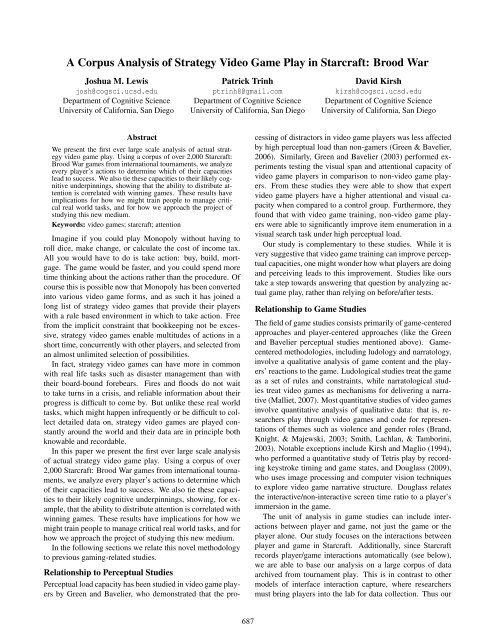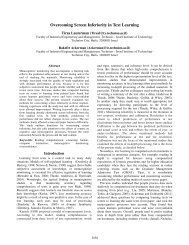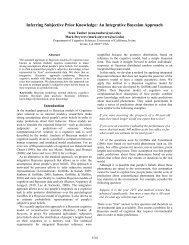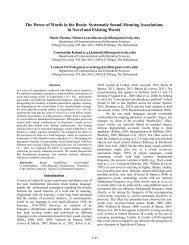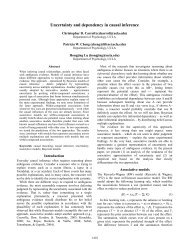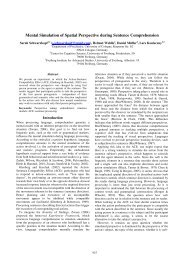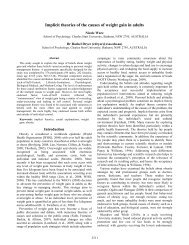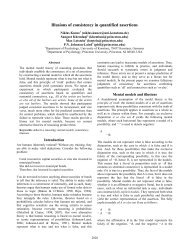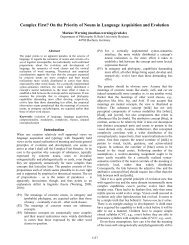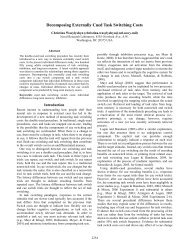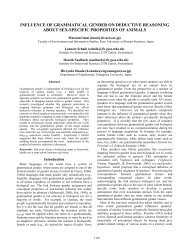A Corpus Analysis of Strategy Video Game Play in Starcraft: Brood ...
A Corpus Analysis of Strategy Video Game Play in Starcraft: Brood ...
A Corpus Analysis of Strategy Video Game Play in Starcraft: Brood ...
Create successful ePaper yourself
Turn your PDF publications into a flip-book with our unique Google optimized e-Paper software.
A <strong>Corpus</strong> <strong>Analysis</strong> <strong>of</strong> <strong>Strategy</strong> <strong>Video</strong> <strong>Game</strong> <strong>Play</strong> <strong>in</strong> <strong>Starcraft</strong>: <strong>Brood</strong> War<br />
Joshua M. Lewis<br />
josh@cogsci.ucsd.edu<br />
Department <strong>of</strong> Cognitive Science<br />
University <strong>of</strong> California, San Diego<br />
Abstract<br />
We present the first ever large scale analysis <strong>of</strong> actual strategy<br />
video game play. Us<strong>in</strong>g a corpus <strong>of</strong> over 2,000 <strong>Starcraft</strong>:<br />
<strong>Brood</strong> War games from <strong>in</strong>ternational tournaments, we analyze<br />
every player’s actions to determ<strong>in</strong>e which <strong>of</strong> their capacities<br />
lead to success. We also tie these capacities to their likely cognitive<br />
underp<strong>in</strong>n<strong>in</strong>gs, show<strong>in</strong>g that the ability to distribute attention<br />
is correlated with w<strong>in</strong>n<strong>in</strong>g games. These results have<br />
implications for how we might tra<strong>in</strong> people to manage critical<br />
real world tasks, and for how we approach the project <strong>of</strong><br />
study<strong>in</strong>g this new medium.<br />
Keywords: video games; starcraft; attention<br />
Imag<strong>in</strong>e if you could play Monopoly without hav<strong>in</strong>g to<br />
roll dice, make change, or calculate the cost <strong>of</strong> <strong>in</strong>come tax.<br />
All you would have to do is take action: buy, build, mortgage.<br />
The game would be faster, and you could spend more<br />
time th<strong>in</strong>k<strong>in</strong>g about the actions rather than the procedure. Of<br />
course this is possible now that Monopoly has been converted<br />
<strong>in</strong>to various video game forms, and as such it has jo<strong>in</strong>ed a<br />
long list <strong>of</strong> strategy video games that provide their players<br />
with a rule based environment <strong>in</strong> which to take action. Free<br />
from the implicit constra<strong>in</strong>t that bookkeep<strong>in</strong>g not be excessive,<br />
strategy video games enable multitudes <strong>of</strong> actions <strong>in</strong> a<br />
short time, concurrently with other players, and selected from<br />
an almost unlimited selection <strong>of</strong> possibilities.<br />
In fact, strategy video games can have more <strong>in</strong> common<br />
with real life tasks such as disaster management than with<br />
their board-bound forebears. Fires and floods do not wait<br />
to take turns <strong>in</strong> a crisis, and reliable <strong>in</strong>formation about their<br />
progress is difficult to come by. But unlike these real world<br />
tasks, which might happen <strong>in</strong>frequently or be difficult to collect<br />
detailed data on, strategy video games are played constantly<br />
around the world and their data are <strong>in</strong> pr<strong>in</strong>ciple both<br />
knowable and recordable.<br />
In this paper we present the first ever large scale analysis<br />
<strong>of</strong> actual strategy video game play. Us<strong>in</strong>g a corpus <strong>of</strong> over<br />
2,000 <strong>Starcraft</strong>: <strong>Brood</strong> War games from <strong>in</strong>ternational tournaments,<br />
we analyze every player’s actions to determ<strong>in</strong>e which<br />
<strong>of</strong> their capacities lead to success. We also tie these capacities<br />
to their likely cognitive underp<strong>in</strong>n<strong>in</strong>gs, show<strong>in</strong>g, for example,<br />
that the ability to distribute attention is correlated with<br />
w<strong>in</strong>n<strong>in</strong>g games. These results have implications for how we<br />
might tra<strong>in</strong> people to manage critical real world tasks, and for<br />
how we approach the project <strong>of</strong> study<strong>in</strong>g this new medium.<br />
In the follow<strong>in</strong>g sections we relate this novel methodology<br />
to previous gam<strong>in</strong>g-related studies.<br />
Relationship to Perceptual Studies<br />
Perceptual load capacity has been studied <strong>in</strong> video game players<br />
by Green and Bavelier, who demonstrated that the pro-<br />
Patrick Tr<strong>in</strong>h<br />
ptr<strong>in</strong>h8@gmail.com<br />
Department <strong>of</strong> Cognitive Science<br />
University <strong>of</strong> California, San Diego<br />
687<br />
David Kirsh<br />
kirsh@cogsci.ucsd.edu<br />
Department <strong>of</strong> Cognitive Science<br />
University <strong>of</strong> California, San Diego<br />
cess<strong>in</strong>g <strong>of</strong> distractors <strong>in</strong> video game players was less affected<br />
by high perceptual load than non-gamers (Green & Bavelier,<br />
2006). Similarly, Green and Bavelier (2003) performed experiments<br />
test<strong>in</strong>g the visual span and attentional capacity <strong>of</strong><br />
video game players <strong>in</strong> comparison to non-video game players.<br />
From these studies they were able to show that expert<br />
video game players have a higher attentional and visual capacity<br />
when compared to a control group. Furthermore, they<br />
found that with video game tra<strong>in</strong><strong>in</strong>g, non-video game players<br />
were able to significantly improve item enumeration <strong>in</strong> a<br />
visual search task under high perceptual load.<br />
Our study is complementary to these studies. While it is<br />
very suggestive that video game tra<strong>in</strong><strong>in</strong>g can improve perceptual<br />
capacities, one might wonder how what players are do<strong>in</strong>g<br />
and perceiv<strong>in</strong>g leads to this improvement. Studies like ours<br />
take a step towards answer<strong>in</strong>g that question by analyz<strong>in</strong>g actual<br />
game play, rather than rely<strong>in</strong>g on before/after tests.<br />
Relationship to <strong>Game</strong> Studies<br />
The field <strong>of</strong> game studies consists primarily <strong>of</strong> game-centered<br />
approaches and player-centered approaches (like the Green<br />
and Bavelier perceptual studies mentioned above). <strong>Game</strong>centered<br />
methodologies, <strong>in</strong>clud<strong>in</strong>g ludology and narratology,<br />
<strong>in</strong>volve a qualitative analysis <strong>of</strong> game content and the players’<br />
reactions to the game. Ludological studies treat the game<br />
as a set <strong>of</strong> rules and constra<strong>in</strong>ts, while narratological studies<br />
treat video games as mechanisms for deliver<strong>in</strong>g a narrative<br />
(Malliet, 2007). Most quantitative studies <strong>of</strong> video games<br />
<strong>in</strong>volve quantitative analysis <strong>of</strong> qualitative data: that is, researchers<br />
play through video games and code for representations<br />
<strong>of</strong> themes such as violence and gender roles (Brand,<br />
Knight, & Majewski, 2003; Smith, Lachlan, & Tambor<strong>in</strong>i,<br />
2003). Notable exceptions <strong>in</strong>clude Kirsh and Maglio (1994),<br />
who performed a quantitative study <strong>of</strong> Tetris play by record<strong>in</strong>g<br />
keystroke tim<strong>in</strong>g and game states, and Douglass (2009),<br />
who uses image process<strong>in</strong>g and computer vision techniques<br />
to explore video game narrative structure. Douglass relates<br />
the <strong>in</strong>teractive/non-<strong>in</strong>teractive screen time ratio to a player’s<br />
immersion <strong>in</strong> the game.<br />
The unit <strong>of</strong> analysis <strong>in</strong> game studies can <strong>in</strong>clude <strong>in</strong>teractions<br />
between player and game, not just the game or the<br />
player alone. Our study focuses on the <strong>in</strong>teractions between<br />
player and game <strong>in</strong> <strong>Starcraft</strong>. Additionally, s<strong>in</strong>ce <strong>Starcraft</strong><br />
records player/game <strong>in</strong>teractions automatically (see below),<br />
we are able to base our analysis on a large corpus <strong>of</strong> data<br />
archived from tournament play. This is <strong>in</strong> contrast to other<br />
models <strong>of</strong> <strong>in</strong>terface <strong>in</strong>teraction capture, where researchers<br />
must br<strong>in</strong>g players <strong>in</strong>to the lab for data collection. Thus our
study extends quantitative analysis <strong>of</strong> game play to an entire<br />
population <strong>of</strong> <strong>Starcraft</strong> players, and is dist<strong>in</strong>ct from studies<br />
that focus on the experiences <strong>of</strong> <strong>in</strong>dividual players. F<strong>in</strong>ally,<br />
<strong>Starcraft</strong> is fundamentally adversarial, which allows us to relate<br />
actions <strong>in</strong> the game to actual w<strong>in</strong> conditions rather than<br />
more synthetic measures <strong>of</strong> performance.<br />
A Partial Taxonomy <strong>of</strong> <strong>Game</strong>s<br />
In order to concretely relate <strong>Starcraft</strong> to other games and<br />
to other challeng<strong>in</strong>g activities that are not traditionally construed<br />
as games, we will develop a partial taxonomy <strong>of</strong> games<br />
us<strong>in</strong>g four fundamental game characteristics. The taxonomy<br />
is partial because it is not <strong>in</strong>tended to differentiate any<br />
two given games, but rather to illustrate differences between<br />
classes <strong>of</strong> games. The four characteristics are stochasticity,<br />
<strong>in</strong>complete <strong>in</strong>formation, unlimited opportunity and asymmetry.<br />
We will def<strong>in</strong>e each characteristic and then discuss <strong>Starcraft</strong>’s<br />
place <strong>in</strong> the taxonomy.<br />
Table 1: A short list <strong>of</strong> games and tasks and their taxonomic<br />
characteristics.<br />
Incomplete Information<br />
Unlimited Opportunity<br />
Asymmetry<br />
Stochastic<br />
<strong>Game</strong>s & Tasks<br />
Chess<br />
Backgammon <br />
H.H. Hippos <br />
Masterm<strong>in</strong>d <br />
Poker <br />
Tennis <br />
<strong>Starcraft</strong> <br />
Disaster Management <br />
Air Traffic Control <br />
Military Command <br />
Stochastic games might restrict player actions based on the<br />
outcome <strong>of</strong> random events (e.g., one’s available moves <strong>in</strong><br />
Backgammon depend on a die roll), or might similarly modify<br />
the game state (e.g., <strong>in</strong> Risk the outcome <strong>of</strong> decid<strong>in</strong>g to<br />
<strong>in</strong>itiate a battle depends on die rolls). Stochastic games might<br />
also modify the game state spontaneously (e.g., w<strong>in</strong>ds push<strong>in</strong>g<br />
a ball <strong>in</strong> Tennis). Of course the behavior <strong>of</strong> die rolls and<br />
w<strong>in</strong>d are the result <strong>of</strong> determ<strong>in</strong>istic processes, but functionally,<br />
for the player, these events are random.<br />
In a game <strong>of</strong> <strong>in</strong>complete <strong>in</strong>formation, the game state is not<br />
fully available to each player. In poker, for example, one does<br />
not know the identity <strong>of</strong> one’s opponents’ cards. In Battleship,<br />
one knows the identity <strong>of</strong> the opponent’s pieces, but not<br />
the position. By contrast, <strong>in</strong> Chess both players know the<br />
688<br />
complete state <strong>of</strong> the game at all times. Much like the Markov<br />
assumption <strong>in</strong> mach<strong>in</strong>e learn<strong>in</strong>g, a Chess player can look at<br />
a board and know everyth<strong>in</strong>g relevant about the state <strong>of</strong> the<br />
game.<br />
<strong>Game</strong>s with unlimited opportunity allow each player to<br />
constantly modify the game state through action (limited only<br />
by each player’s capabilities). In games like Checkers and<br />
Chess, one can only modify the state <strong>of</strong> the game with a s<strong>in</strong>gle<br />
action when it is one’s turn. Thus the opportunity to act <strong>in</strong><br />
those games is limited, both <strong>in</strong> tim<strong>in</strong>g and number. In Hungry<br />
Hungry Hippos there are no such constra<strong>in</strong>ts—one can constantly<br />
attempt to collect marbles with one’s hippo, limited<br />
only by one’s hippo-lever<strong>in</strong>g capabilities. Unlimited opportunity<br />
is compatible with turn-tak<strong>in</strong>g. In Tennis a player must<br />
take turns hitt<strong>in</strong>g the ball, but he or she can constantly be<br />
mov<strong>in</strong>g and chang<strong>in</strong>g the state <strong>of</strong> the game. In Chess, though<br />
one might be constantly th<strong>in</strong>k<strong>in</strong>g and plann<strong>in</strong>g regardless <strong>of</strong><br />
turn, those thoughts and plans do not change the game state<br />
and opportunity is still limited.<br />
Asymmetric games provide players with dist<strong>in</strong>ct materials,<br />
action repertoires, or territory. Basketball is asymmetric because<br />
the players’ bodies, equipment and action repertoires<br />
are different (though the territory is symmetric). Checkers<br />
and Hungry Hungry Hippos are mostly symmetric (barr<strong>in</strong>g<br />
color, the slight who-goes-first asymmetry <strong>in</strong> turn tak<strong>in</strong>g<br />
games, and the stochastic distribution <strong>of</strong> hippo marbles).<br />
One notable meta-characteristic <strong>of</strong> a game is whether humans<br />
are able to perform optimally when play<strong>in</strong>g it. Given<br />
an hour <strong>of</strong> contemplation and practice, most players can master<br />
Tic-tac-toe and never receive worse than a draw. Humans<br />
cannot perform optimally <strong>in</strong> most games, <strong>in</strong>clud<strong>in</strong>g Chess,<br />
Go, Tennis, and <strong>Starcraft</strong>. Thus while it may be tempt<strong>in</strong>g to<br />
<strong>in</strong>terpret the above characteristics <strong>in</strong> terms <strong>of</strong> what makes a<br />
game more difficult (and therefore more <strong>in</strong>terest<strong>in</strong>g to study),<br />
that dist<strong>in</strong>ction is likely to be mean<strong>in</strong>gless because humans<br />
are play<strong>in</strong>g aga<strong>in</strong>st humans and they are far from optimal play<br />
anyways.<br />
We propose, separate from any arguments about difficulty,<br />
that games are <strong>in</strong>terest<strong>in</strong>g to study when they share structure<br />
with other tasks that are important and that we would like to<br />
perform better at. Chess is <strong>in</strong>terest<strong>in</strong>g because <strong>of</strong> its relationship<br />
to formal reason<strong>in</strong>g and plann<strong>in</strong>g (and was thus a darl<strong>in</strong>g<br />
<strong>of</strong> GOFAI). <strong>Starcraft</strong> is <strong>in</strong>terest<strong>in</strong>g because it shares structure<br />
with disaster management, air traffic control and military<br />
command (see Table 1).<br />
Two concerns immediately arise. First, the taxonomy<br />
glosses over important dist<strong>in</strong>ctions between, say, air traffic<br />
control and <strong>Starcraft</strong>. There is no explicit adversary <strong>in</strong> air<br />
traffic control, and the materials are planes and pilots, which<br />
have significant autonomy. Of course there will be significant<br />
dist<strong>in</strong>ctions between real world tasks and games 1 , but we believe<br />
<strong>Starcraft</strong> has enough structural similarity, and certa<strong>in</strong>ly<br />
more than, say, Chess, to be worth study<strong>in</strong>g. The second con-<br />
1 The field <strong>of</strong> serious games tries to m<strong>in</strong>imize those dist<strong>in</strong>ctions<br />
so that solv<strong>in</strong>g <strong>in</strong>-game problems solves real problems concurrently.
cern, then, is “Why <strong>Starcraft</strong>?” What makes <strong>Starcraft</strong> more<br />
appropriate an object <strong>of</strong> study than any other <strong>of</strong> the many,<br />
many real-time strategy games that share its structure? In the<br />
follow<strong>in</strong>g section we describe <strong>Starcraft</strong> and show why it is<br />
not just a game to study <strong>in</strong> this genre, but unequivocally the<br />
best game to study.<br />
<strong>Game</strong> Basics<br />
<strong>Starcraft</strong>: <strong>Brood</strong> War<br />
<strong>Starcraft</strong>: <strong>Brood</strong> War is a computer game that <strong>in</strong>volves 2 players<br />
2 , who manage an armed conflict from an angled top-down<br />
perspective. The players use units, similar to Chess pieces,<br />
that have different strengths, weaknesses, and capabilities <strong>in</strong><br />
order to defeat opponent units and destroy opponent structures.<br />
Units battle on a two dimensional map, which is completely<br />
obscured from the player until revealed by his or her<br />
units. Additionally, the player’s primary view <strong>of</strong> the map<br />
only spans a small movable portion <strong>of</strong> the entire play<strong>in</strong>g field<br />
(see Figure 1 for a sample screenshot from the game). These<br />
design characteristics make <strong>Starcraft</strong> a game <strong>of</strong> <strong>in</strong>complete<br />
<strong>in</strong>formation where efficiently distribut<strong>in</strong>g one’s attention is<br />
paramount.<br />
<strong>Starcraft</strong> players act simultaneously and cont<strong>in</strong>uously to<br />
accomplish their goals. <strong>Starcraft</strong> is a game <strong>of</strong> unlimited opportunity:<br />
there is no explicit limit on the number or frequency<br />
<strong>of</strong> actions players can execute to change the state <strong>of</strong><br />
the game. The units themselves can follow commands with<br />
a degree <strong>of</strong> autonomy. They can navigate obstacles on the<br />
way to a target location supplied by the player, or respond<br />
when attacked. These behaviors are simple and sometimes<br />
unpredictable, so players must manage units constantly <strong>in</strong> order<br />
to ensure desired behavior. This behavior, comb<strong>in</strong>ed with<br />
a random miss chance on some attacks, makes <strong>Starcraft</strong> functionally<br />
stochastic.<br />
In the same way that acquir<strong>in</strong>g money <strong>in</strong> Monopoly allows<br />
one to buy properties and acquire yet more money, economy<br />
management is crucial to success <strong>in</strong> <strong>Starcraft</strong>. Two resources,<br />
m<strong>in</strong>erals and gas, are distributed throughout the map to be<br />
harvested by players’ worker units. In order to efficiently<br />
gather resources from these areas players must build new<br />
build<strong>in</strong>gs close to these resources and protect their worker<br />
units while prevent<strong>in</strong>g their opponent from do<strong>in</strong>g likewise.<br />
<strong>Play</strong>ers use the resources they collect to build <strong>of</strong>fensive units<br />
and build<strong>in</strong>gs that <strong>in</strong>crease their chance <strong>of</strong> victory. Thus,<br />
economy management <strong>in</strong> <strong>Starcraft</strong> revolves around secur<strong>in</strong>g<br />
and harvest<strong>in</strong>g resources and outproduc<strong>in</strong>g one’s opponent—<br />
a difficult task when one is concurrently engaged <strong>in</strong> multiple<br />
skirmishes around the map.<br />
<strong>Starcraft</strong>’s asymmetry is <strong>in</strong>tegral to its appeal. <strong>Play</strong>ers play<br />
as one <strong>of</strong> three factions, Zerg, Terran, or Protoss, with each<br />
faction hav<strong>in</strong>g a completely dist<strong>in</strong>ct set <strong>of</strong> units and build<strong>in</strong>gs.<br />
<strong>Game</strong>s progress very differently depend<strong>in</strong>g on the match up,<br />
the comb<strong>in</strong>ation <strong>of</strong> factions, present <strong>in</strong> the game. There are<br />
2 The game supports up to eight players, but almost all pr<strong>of</strong>essional<br />
competition is one on one.<br />
689<br />
Figure 1: Screenshots from the strategy video game <strong>Starcraft</strong>:<br />
<strong>Brood</strong> War. Top, the aftermath <strong>of</strong> a skirmish between Protoss<br />
and Zerg units. Bottom, Protoss workers m<strong>in</strong>e m<strong>in</strong>erals and<br />
gas <strong>in</strong> the Protoss player’s ma<strong>in</strong> base.<br />
six possible comb<strong>in</strong>ations, the mirror match ups: Zerg vs.<br />
Zerg (ZvZ), Protoss vs. Protoss (PvP), Terran vs. Terran<br />
(TvT), and the mixed match ups: Zerg vs. Terran (ZvT), Zerg<br />
vs. Protoss (ZvP), Terran vs. Protoss (TvP). A complete discussion<br />
<strong>of</strong> the strategic differences between the match ups is<br />
outside the scope <strong>of</strong> this paper, but suffice it to say that they<br />
are substantial enough to warrant separate analysis.<br />
The design characteristics <strong>of</strong> <strong>Starcraft</strong> place it <strong>in</strong> a unique<br />
branch <strong>of</strong> our game taxonomy, dist<strong>in</strong>ct from games like Chess<br />
and Backgammon, but similar to real world tasks like disaster<br />
management (see Table 1).<br />
History, Cultural Impact, and Study<br />
<strong>Starcraft</strong> was created by Blizzard Enterta<strong>in</strong>ment and released<br />
<strong>in</strong> 1998. Its expansion, <strong>Starcraft</strong>: <strong>Brood</strong> War, was also released<br />
<strong>in</strong> 1998, and it is the version that is played competitively.<br />
Though the game has been around for quite some time<br />
it is still quite popular, particularly <strong>in</strong> South Korea, and still
the subject <strong>of</strong> strategic analysis, from a class develop<strong>in</strong>g theory<br />
for pr<strong>of</strong>icient <strong>Starcraft</strong> play to an AI competition set <strong>in</strong><br />
the game environment.<br />
South Korea is host to the world’s most developed pr<strong>of</strong>essional<br />
gam<strong>in</strong>g league, which is devoted entirely to <strong>Starcraft</strong>.<br />
Eleven teams each with approximately 15 players compete <strong>in</strong><br />
televised matches across three 24/7 networks devoted exclusively<br />
to esports. While the best players are national celebrities<br />
and can earn well north <strong>of</strong> $100,000 a year <strong>in</strong> salary, w<strong>in</strong>n<strong>in</strong>gs<br />
and endorsements, they practice 10 to 13 hours a day,<br />
live <strong>in</strong> team dormitories, and are discouraged from socializ<strong>in</strong>g<br />
outside the team. This extreme lifestyle has created a population<br />
<strong>of</strong> pr<strong>of</strong>essional gamers that can execute over 400 actions<br />
per m<strong>in</strong>ute (APM) <strong>in</strong> the game. By contrast, a highly accomplished<br />
amateur <strong>in</strong> the United States would likely top out <strong>in</strong><br />
the mid 200s (beg<strong>in</strong>ners start at well under 100 APM). In the<br />
context <strong>of</strong> <strong>Starcraft</strong>, <strong>in</strong>ternational play is def<strong>in</strong>ed as play anywhere<br />
outside <strong>of</strong> South Korea.<br />
UC Berkeley recently ran a student-led class that modeled<br />
advanced aspects <strong>of</strong> the game. Topics <strong>in</strong>cluded calculat<strong>in</strong>g<br />
the effectiveness <strong>of</strong> unit spatial distribution by calculat<strong>in</strong>g<br />
the rate at which <strong>in</strong>dividual units give and receive damage,<br />
and classify<strong>in</strong>g strategies used by pr<strong>of</strong>essional Korean players<br />
through game theoretic analysis (Crecente, 2009).<br />
The Expressive Intelligence Studio at UC Santa Cruz<br />
hosted a <strong>Starcraft</strong> AI tournament <strong>in</strong> which colleges submitted<br />
AI bots to play <strong>Starcraft</strong> aga<strong>in</strong>st each other (Expressive<br />
Intelligence Studio, 2010). UC Berkeleys w<strong>in</strong>n<strong>in</strong>g entry used<br />
the computers ability to perform an unlimited number <strong>of</strong> actions<br />
per m<strong>in</strong>ute to create a difficult to defeat patterns <strong>of</strong> unit<br />
motion (Huang, 2011).<br />
Replays<br />
Crucial to our analysis is the replay file, a <strong>Starcraft</strong> feature<br />
that allows users to re-watch games after they have concluded.<br />
These replay files are records <strong>of</strong> the actions that<br />
both players took and the time that each one occurred. The<br />
files are stored <strong>in</strong> a proprietary b<strong>in</strong>ary format, but developers<br />
have created s<strong>of</strong>tware that can decode them <strong>in</strong> order to<br />
catch cheaters and perform basic analyses <strong>of</strong> <strong>in</strong>dividual play.<br />
iCCup, the largest organizer <strong>of</strong> <strong>in</strong>ternational <strong>Starcraft</strong> tournaments,<br />
keeps a repository <strong>of</strong> replay files from recent tournaments.<br />
The repository allows any player to download and<br />
view replays from high-level players around the world, and<br />
it allows us to gather a large amount <strong>of</strong> data easily. Unfortunately<br />
some details that would be useful for analysis are not<br />
conta<strong>in</strong>ed <strong>in</strong> the replay files, such as the amount <strong>of</strong> resources<br />
and units controlled by each player, the positions <strong>of</strong> units and<br />
build<strong>in</strong>gs, and where the players are look<strong>in</strong>g on the map. We<br />
must base our analysis solely on actions taken by the players.<br />
No strategy video game has the level <strong>of</strong> pr<strong>of</strong>essional and<br />
amateur play, availability <strong>of</strong> data and tools, and depth <strong>of</strong> understand<strong>in</strong>g<br />
through both analysis and experience, that <strong>Starcraft</strong><br />
has. For these reasons, it is unequivocally the best strat-<br />
690<br />
egy video game to study.<br />
Methods<br />
We collected 2,302 replay files from <strong>Starcraft</strong> games played<br />
<strong>in</strong> <strong>in</strong>ternational tournaments (i.e., outside South Korea) between<br />
August 2010 and January 2011 from iCCup. After exclud<strong>in</strong>g<br />
games where the players did not both have over 75<br />
APM 3 , or where the w<strong>in</strong>ner could not be determ<strong>in</strong>ed, our f<strong>in</strong>al<br />
corpus consisted <strong>of</strong> 2,015 games.<br />
Build<strong>in</strong>g upon András Belicza’s Java package for analyz<strong>in</strong>g<br />
<strong>Starcraft</strong> replays to detect cheaters (Belicza, 2011), we<br />
wrote analysis s<strong>of</strong>tware <strong>in</strong> Java to extract summary statistics<br />
<strong>of</strong> the actions taken <strong>in</strong> each game. For each game and each<br />
player we record the follow<strong>in</strong>g:<br />
1. Actions per m<strong>in</strong>ute (APM), calculated as the total number<br />
<strong>of</strong> actions over game time <strong>in</strong> m<strong>in</strong>utes.<br />
2. Spatial variance <strong>of</strong> action (SVA), the 2D spatial variance<br />
<strong>of</strong> all actions with location, such as plac<strong>in</strong>g a build<strong>in</strong>g or<br />
mov<strong>in</strong>g units.<br />
3. Macro action count, the total number <strong>of</strong> macro-related actions.<br />
Macro actions are those that help build the economy<br />
and production <strong>of</strong> a player.<br />
4. Micro action count, the total number <strong>of</strong> micro-related actions.<br />
Micro actions are those that manage units dur<strong>in</strong>g<br />
battle, scout<strong>in</strong>g or position<strong>in</strong>g.<br />
5. W<strong>in</strong> state, 1 or 0 depend<strong>in</strong>g on whether the player won.<br />
We also record the faction used by each player, and the total<br />
game time. While it would be nice to record where players<br />
were look<strong>in</strong>g on the map and how much material they had at<br />
each po<strong>in</strong>t <strong>in</strong> the game, these data are not present <strong>in</strong> the replay<br />
files as mentioned above.<br />
Because each faction plays differently, and each match up<br />
is dist<strong>in</strong>ct 4 , we separate our results out by w<strong>in</strong> state, faction<br />
and match up. We perform two-way, one-tailed positive ttests<br />
only between w<strong>in</strong>ners and losers with<strong>in</strong> a particular faction/match<br />
up comb<strong>in</strong>ation for both APM and SVA, where<br />
the variances are not assumed to be equal. While the same<br />
comb<strong>in</strong>ation <strong>of</strong> players <strong>in</strong> a match sometimes appear multiple<br />
times <strong>in</strong> the corpus we feel the games themselves are dist<strong>in</strong>ct<br />
enough 5 to warrant treat<strong>in</strong>g them as <strong>in</strong>dependent samples.<br />
Results<br />
Because our games are collected from actual tournament play,<br />
the number <strong>of</strong> samples for each w<strong>in</strong> state/faction/match up<br />
comb<strong>in</strong>ation are different. Table 2 shows the sample size for<br />
each comb<strong>in</strong>ation and Table 3 shows the mean game length<br />
<strong>in</strong> seconds.<br />
3 We exclude 75 APM and below <strong>in</strong> order to filter out low skill<br />
players and player slots filled by third party observers <strong>of</strong> the match.<br />
4 For example, a high APM <strong>in</strong> one match up might be low for<br />
another match up.<br />
5 They likely occur on different maps, and players must vary their<br />
strategies to avoid becom<strong>in</strong>g predictable.
Table 2: Sample size for each w<strong>in</strong> state/faction/match up.<br />
AvB ZvZ TvT PvP ZvT ZvP TvP<br />
Faction A w<strong>in</strong>s 189 49 348 83 165 233<br />
Faction A loses 189 49 348 239 453 256<br />
Faction B w<strong>in</strong>s 239 453 256<br />
Faction B loses 83 165 233<br />
Table 3: Mean game length <strong>in</strong> seconds for each w<strong>in</strong><br />
state/faction/match up. Note that as <strong>in</strong> Table 2 the game<br />
length for a faction A loss is the same as the game length<br />
for a faction B w<strong>in</strong>, and vice versa, so only one is reported.<br />
AvB ZvZ TvT PvP ZvT ZvP TvP<br />
Faction A w<strong>in</strong>s 551 944 749 806 795 932<br />
Faction B w<strong>in</strong>s 819 856 919<br />
Figure 2 (top) shows the mean APM for each w<strong>in</strong><br />
state/faction/match up. All with<strong>in</strong> faction/match up and<br />
across w<strong>in</strong> state comparisons are significant at α = 0.0056<br />
(after a Bonferroni correction for N = 9 comparisons) except<br />
TvT, Zerg <strong>in</strong> ZvT, and Protoss <strong>in</strong> ZvP. Notably, though, even<br />
for comparisons that are not significant, the trend is <strong>in</strong> the correct<br />
direction. If the match up is AvB, then the blue columns<br />
show the results for faction A, and the yellow and red columns<br />
show the results for faction B, with the w<strong>in</strong>n<strong>in</strong>g column on the<br />
left with<strong>in</strong> each pair. The ability to quickly perform actions<br />
<strong>in</strong> the game is clearly correlated with success.<br />
Figure 2 (middle) shows the mean SVA for each w<strong>in</strong><br />
state/faction/match up. All with<strong>in</strong> faction/match up and<br />
across w<strong>in</strong> state comparisons are significant at α = 0.0056<br />
(after a Bonferroni correction for N = 9 comparisons) except<br />
TvT, Terran <strong>in</strong> ZvT, and Zerg <strong>in</strong> ZvP. Similar to APM, the<br />
trend is always <strong>in</strong> the correct direction. A good spatial distribution<br />
<strong>of</strong> actions (and thus attention, see discussion below) is<br />
quite predictive <strong>of</strong> success <strong>in</strong> most cases.<br />
Figure 2 (bottom) shows the proportion <strong>of</strong> macro actions<br />
(those relat<strong>in</strong>g to the economy and production <strong>of</strong> a player)<br />
to micro actions (those related to unit control) for each w<strong>in</strong><br />
state/faction/match up. ZvZ, which is considered a very<br />
micro-<strong>in</strong>tensive match up by players, shows a notably lower<br />
proportion <strong>of</strong> macro actions. There does not seem to be a<br />
consistent relationship between macro action proportion and<br />
w<strong>in</strong>n<strong>in</strong>g, however.<br />
Discussion<br />
We f<strong>in</strong>d that subjects that are able to most quickly execute<br />
actions tend to w<strong>in</strong>. While a high APM could simply be a<br />
proxy for practice and experience, we believe it also ameliorates<br />
issues posed by functionally stochastic unit navigation<br />
behavior. S<strong>in</strong>ce the majority <strong>of</strong> actions are related to unit con-<br />
691<br />
Figure 2: Mean APM (top), SVA (middle) and proportion<br />
<strong>of</strong> macro to micro actions (bottom) for each w<strong>in</strong><br />
state/faction/match up. With<strong>in</strong> faction/match up and across<br />
w<strong>in</strong> state comparisons (dark blue to light blue for faction<br />
A and yellow to red or faction B) that are significant at<br />
α = 0.0056 (after a Bonferroni correction for N = 9 comparisons)<br />
are marked with an asterisk.<br />
trol, the additional actions allow players to more precisely<br />
determ<strong>in</strong>e unit behavior. Another way to look at it is that,<br />
due to unlimited opportunity, the players who have the higher<br />
APM change the game state the most. S<strong>in</strong>ce they are try<strong>in</strong>g to<br />
change the game state <strong>in</strong> their favor these changes are likely<br />
good for them, unless they make a mistake.<br />
<strong>Play</strong>er SVA is an <strong>in</strong>direct measure <strong>of</strong> the distribution <strong>of</strong> a<br />
player’s attention. It would be hard for one to take action on<br />
a part <strong>of</strong> the map that one is not at least partially attend<strong>in</strong>g<br />
to. Given this characterization, we see that the ability to distribute<br />
attention and actions around the map (e.g. by scout<strong>in</strong>g<br />
<strong>in</strong> the other players base, or harvest<strong>in</strong>g resources from a different<br />
part <strong>of</strong> the map than one’s base) leads to success <strong>in</strong>
<strong>Starcraft</strong>. 6 In the tradition <strong>of</strong> Green and Bavelier, one could<br />
imag<strong>in</strong>e test<strong>in</strong>g subjects for multi-task<strong>in</strong>g capacity before and<br />
after <strong>Starcraft</strong> tra<strong>in</strong><strong>in</strong>g. With these data we could then correlate<br />
any improvement with actual changes <strong>in</strong> their attention/action<br />
distribution <strong>in</strong> the games they played for greater<br />
<strong>in</strong>sight <strong>in</strong>to the learn<strong>in</strong>g process.<br />
Both APM and SVA are useful <strong>in</strong> <strong>Starcraft</strong> due to specific<br />
components <strong>of</strong> its design. With a high APM, one can better<br />
reduce the stochasticity <strong>of</strong> unit movement and take advantage<br />
<strong>of</strong> the unlimited opportunity for action <strong>Starcraft</strong> <strong>of</strong>fers. With<br />
a high SVA, a player reduces the amount <strong>of</strong> uncerta<strong>in</strong>ty due<br />
to <strong>in</strong>complete <strong>in</strong>formation by act<strong>in</strong>g on and reveal<strong>in</strong>g more<br />
areas <strong>of</strong> the map. In a game that does not have these design<br />
characteristics, such as Chess, APM and SVA should have no<br />
correlation to w<strong>in</strong> rates. Clearly Chess players do not practice<br />
the physical act <strong>of</strong> mov<strong>in</strong>g pieces on the board–there’s<br />
no need. Even <strong>in</strong> Speed Chess the emphasis is on quickly<br />
develop<strong>in</strong>g a strategy and determ<strong>in</strong><strong>in</strong>g the current s<strong>in</strong>gle best<br />
move, not on physically execut<strong>in</strong>g a large number <strong>of</strong> moves<br />
<strong>in</strong> a short time span. If one were manag<strong>in</strong>g a disaster, though,<br />
high APM should lead to <strong>in</strong>creased performance (e.g. check<strong>in</strong>g<br />
<strong>in</strong> <strong>of</strong>ten with workers <strong>in</strong> the field, issu<strong>in</strong>g <strong>in</strong>structions,<br />
etc.), s<strong>in</strong>ce the task has similar taxonomic characteristics.<br />
These replay data, which constitute simply a list <strong>of</strong> actions<br />
undertaken by each player, are only a subset <strong>of</strong> the quantitative<br />
data that could be gathered on <strong>Starcraft</strong> play (though<br />
they are the only data suitable for a large scale corpus analysis<br />
such as this). With access to players and their mach<strong>in</strong>es,<br />
one could imag<strong>in</strong>e collect<strong>in</strong>g eye movements, mouse traces,<br />
more detailed game state (e.g. changes <strong>in</strong> material, visual<br />
complexity), first person video and audio and hand and body<br />
movements. We have developed a simple application to measure<br />
visual complexity with first person video, and we would<br />
like to cont<strong>in</strong>ue develop<strong>in</strong>g tools to allow a more f<strong>in</strong>e-gra<strong>in</strong>ed<br />
<strong>in</strong>vestigation <strong>of</strong> <strong>Starcraft</strong> play.<br />
This study develops a novel methodology for analyz<strong>in</strong>g<br />
video game play <strong>in</strong> the wild. Through an analysis <strong>of</strong> over<br />
2,000 competitive <strong>Starcraft</strong> games, we show that the ability<br />
to change the game state more frequently, and to distribute<br />
one’s attention and actions around to map leads to success<br />
<strong>in</strong> the game. S<strong>in</strong>ce <strong>Starcraft</strong> shares structure with important<br />
endeavors such as disaster management and air traffic control,<br />
we believe that a better understand<strong>in</strong>g <strong>of</strong> what improves<br />
<strong>Starcraft</strong> play can lead to better tra<strong>in</strong><strong>in</strong>g for other challeng<strong>in</strong>g<br />
tasks.<br />
6 One could argue that a player tak<strong>in</strong>g action over a larger area <strong>of</strong><br />
the map controls a larger area and is thus more likely to w<strong>in</strong> because<br />
they are already ahead. While some games <strong>of</strong> <strong>Starcraft</strong> are won<br />
by build<strong>in</strong>g more bases and a larger economy than one’s opponent,<br />
other common strategies <strong>in</strong>volve strong attacks <strong>of</strong>f <strong>of</strong> one or two<br />
bases while the opponent is attempt<strong>in</strong>g to take more <strong>of</strong> the map.<br />
Thus we do not th<strong>in</strong>k that the SVA f<strong>in</strong>d<strong>in</strong>g is solely the result <strong>of</strong> map<br />
control.<br />
692<br />
Acknowledgments<br />
Thanks to Darren Lou and Mohamed Mirza for their valuable<br />
assistance on this project. Thanks to András Belicza for develop<strong>in</strong>g<br />
the Java replay analysis package we used to collect<br />
the data, and k<strong>in</strong>dly answer<strong>in</strong>g our questions.<br />
References<br />
Belicza, A. (2011). <strong>Starcraft</strong> <strong>Brood</strong>war<br />
hacker f<strong>in</strong>der, anti-hack, replay analyzerorganizer<br />
and utility tool. Available from<br />
http://code.google.com/p/bwhf/source/browse/<br />
Brand, J., Knight, S., & Majewski, J. (2003). The diverse<br />
worlds <strong>of</strong> computer games: A content analysis <strong>of</strong> spaces,<br />
populations, styles and narratives. In Level up: Digital<br />
games research conference. Utrecht, Netherlands: Digital<br />
<strong>Game</strong>s Research Association.<br />
Crecente, B. (2009). Competitive <strong>Starcraft</strong> gets UC Berkeley<br />
class. Available from http://kotaku.com/5141355/<br />
competitive-starcraft-gets-uc-berkeley-class<br />
Douglass, J. (2009). Computer visions <strong>of</strong> computer games:<br />
analysis and visualization <strong>of</strong> play record<strong>in</strong>gs. In Workshop<br />
on media arts, science, and technology (mast) 2009: The<br />
future <strong>of</strong> <strong>in</strong>teractive media. UC Santa Barbara.<br />
Expressive Intelligence Studio. (2010). <strong>Starcraft</strong><br />
AI competition. Available from<br />
http://eis.ucsc.edu/StarCraftAICompetition<br />
Green, C. S., & Bavelier, D. (2003). Action video game<br />
modifies visual selective attention. Nature, 423, 534–537.<br />
Green, C. S., & Bavelier, D. (2006). Effect <strong>of</strong> action video<br />
games on the spatial distribution <strong>of</strong> visuospatial attention.<br />
Journal <strong>of</strong> Experimental Psychology: Human Perception<br />
and Performance, 32(6), 1465 - 1478.<br />
Huang, H. (2011). Skynet meets the swarm:<br />
how the Berkeley Overm<strong>in</strong>d won the 2010<br />
<strong>Starcraft</strong> AI competition. Available from<br />
http://arstechnica.com/gam<strong>in</strong>g/news/2011/01/<br />
skynet-meets-the-swarm-how-the-berkeleyoverm<strong>in</strong>d-won-the-2010-starcraft-aicompetition.ars/<br />
Kirsh, D., & Maglio, P. (1994). On dist<strong>in</strong>guish<strong>in</strong>g epistemic<br />
from pragmatic action. Cognitive Science, 18, 513–549.<br />
Malliet, S. (2007). Adapt<strong>in</strong>g the pr<strong>in</strong>ciples <strong>of</strong> ludology to the<br />
method <strong>of</strong> video game content analysis. <strong>Game</strong> Studies, 7.<br />
Smith, S. L., Lachlan, K., & Tambor<strong>in</strong>i, R. (2003). Popular<br />
video games: Quantify<strong>in</strong>g the presentation <strong>of</strong> violence and<br />
its context. Journal <strong>of</strong> Broadcast<strong>in</strong>g and Electronic Media,<br />
47, 58–76.


